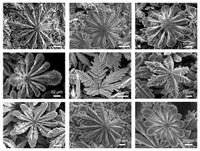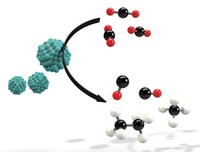Advertisement
Grab your lab coat. Let's get started
Welcome!
Welcome!
Create an account below to get 6 C&EN articles per month, receive newsletters and more - all free.
It seems this is your first time logging in online. Please enter the following information to continue.
As an ACS member you automatically get access to this site. All we need is few more details to create your reading experience.
Not you? Sign in with a different account.
Not you? Sign in with a different account.
ERROR 1
ERROR 1
ERROR 2
ERROR 2
ERROR 2
ERROR 2
ERROR 2
Password and Confirm password must match.
If you have an ACS member number, please enter it here so we can link this account to your membership. (optional)
ERROR 2
ACS values your privacy. By submitting your information, you are gaining access to C&EN and subscribing to our weekly newsletter. We use the information you provide to make your reading experience better, and we will never sell your data to third party members.
Materials
Powerful Pull To New Magnets
Supply problems with vital rare-earth metals attract new magnet-making methods
by Mitch Jacoby
January 7, 2013
| A version of this story appeared in
Volume 91, Issue 1
Ames Laboratory associate scientist Ryan Ott describes rare-earth magnet recycling. Researchers in the Ames Lab are working to more effectively remove the neodymium, a rare earth, from the mix of other materials in a magnet.
If necessity is the mother of invention, science and technology must be due soon to give birth to new materials and methods for making powerful permanent magnets.
The magnets are crucial to an enormous number of products in the automobile, electronics, power-generation, and clean-energy industries. But worldwide, it has been difficult to secure the supply of neodymium, dysprosium, and other rare-earth metals in these powerful magnets, which are stronger yet much smaller than those made with other materials. Recently rare-earth metal prices have fluctuated wildly.
In 2010, many publications, including this one, reported on China’s global monopoly on production of rare-earth metals and oxides and the country’s plans to drastically cut exports (C&EN, Aug. 30, 2010, page 9). The news caused demand for and prices of these materials, especially of dysprosium, one of the scarcest rare-earth metals, to soar. But then other market factors caused prices to fall sharply.
Rather than hunting for completely novel building blocks from which to construct new magnets free of rare-earth metals, many scientists are looking for methods to control the building blocks of known magnetic substances on a finer scale. The strategy could lead to more magnetism from less material. A handful of those researchers gathered at the recent Materials Research Society meeting in Boston to share their latest findings. They and other scientists are working to understand nanoscale magnetic phenomena and to use that information to develop a bottom-up approach to magnet-making. Other researchers are responding to the challenge by exploring methods for extracting the valuable metals from already-used commercial products, allowing them to make recycled rare-earth magnets.
People have been making magnets for more than 150 years, says Steven Constantinides, director of technology at Arnold Magnetic Technologies, Rochester, N.Y. During that time, magnet makers have covered a large fraction of the periodic table searching for building blocks for magnetic materials. And the rare-earth substance neodymium iron boron has been the champion for a long time. “Anything is possible,” Constantinides admits, “but it would be a little presumptuous to think that simply mixing raw materials today in some slightly different way is going to lead to a new magnetic material that is far superior.”


David J. Sellmyer, a physics professor at the University of Nebraska, Lincoln, agrees. “In this field, that would be like setting out to hit a grand slam home run.” He explains that Nd2Fe14B magnets’ outstanding strength has made them indispensable to modern computer disk drives, a variety of large and tiny audio speakers, and many types of motors and motor generators crucial to the performance of hybrid automobiles and electricity-generating windmills.
The high strength of Nd2Fe14B and other rare-earth-based magnetic materials such as samarium cobalt (SmCo5) leads to powerful yet relatively small and lightweight magnets. That strength, which is often expressed as a “magnetic energy product,” can be on the order of 56 megagauss-oersteds (MGOe). A common refrigerator magnet, based on iron, is less than 1 MGOe.
One new research thrust in the bottom-up category takes its cue from the inner workings of rare-earth magnets. In Nd2Fe14B, for example, the transition metal is the source of the high magnetization. The rare-earth component is responsible for the high value of a property known as magnetocrystalline anisotropy, which is related to a magnet’s resistance to becoming demagnetized. The underlying idea is to engineer composite materials that combine high magnetization and high anisotropy components.
“The trick is bringing these components together on a very short length scale—about 10 nm,” Sellmyer says. At that scale, the two components are intimately tied to each other magnetically, or what experts in this field describe as strongly exchange coupled. The concept has been around since the 1990s, Sellmyer points out, but it has been difficult to implement. Despite recent advances in synthesizing a large variety of nanoparticles, researchers have found it challenging to control the size, crystal structure, and phase purity of exchange-coupled nanoparticles. One source of that challenge is a high-temperature treatment, usually above 500 °C—it causes nanoparticles to coalesce and grow to large size.
To overcome the size and structure problems, Sellmyer, Balamurugan Balasubramanian, and coworkers, including the University of Delaware’s George C. Hadjipanayis, developed a heat-treatment-free cluster deposition technique for making nanoparticles. In one application of that method, the team fabricated new rare-earth transition-metal nanoparticles by sputtering an yttrium-cobalt target. That process, which resembles atomic-scale sandblasting, generates vapors of Y and Co atoms that cool and directly aggregate into uniform-sized crystalline YCo5 and Y2Co17 nanoparticles measuring less than 10 nm in diameter. The proof-of-concept study shows that the method can be used to fabricate well-ordered magnetic nanoparticles for further analysis (Nano Lett., DOI: 10.1021/nl200311w).
The team also applied the method to making rare-earth-free hafnium-cobalt nanomagnets and nanocomposites of HfCo7 encapsulated in an FeCo phase. Like the Y-Co particles, the HfCo7 nanoparticles are also well ordered and tend to be less than 10 nm in diameter. Sellmyer points out that this sputter-based cluster methodology for making nanocomposites can be readily adapted to produce other types of permanent-magnet alloys including next-generation high-performance magnets (Appl. Phys. Lett., DOI: 10.1063/1.4753950).
Laura H. Lewis, a chemical engineering professor at Northeastern University, is also looking for ways to exploit nanoscale structuring in non-rare-earth alloys such that the commingling of the components (exchange coupling) locks the material’s magnetization in place, thereby forming strong permanent magnets. In one study of that type, Lewis, Félix Jiménez-Villacorta, and coworkers rapidly cooled arc-melted samples of a Mn55Al45 alloy to force the manganese-aluminum material to solidify in nonequilibrium phases and structures. Magnetic and structural analyses show that this simple treatment of a two-metal alloy yields products that exhibit enhanced magnetic anisotropy. The team attributes the change in magnetic properties to intimate mixing of metastable Mn-rich and Mn-poor regions (Appl. Phys. Lett., DOI: 10.1063/1.3695153).

In related work on inexpensive rare-earth-free magnets, Lewis and coworkers have also been studying Fe-Ni alloys. The description may sound pedestrian, but the samples’ origins are out of this world—literally. The group, which includes Arif Mubarok and Joseph I. Goldstein of the University of Massachusetts, Amherst, has been analyzing samples of an uncommon Fe-Ni phase known as tetrataenite that were obtained from meteorites.
Tetrataenite, which has desirable magnetic properties, is characterized by a well-ordered lattice of alternating layers of iron and nickel that lock the alloy’s magnetization in place. According to Mubarok, the material was analyzed decades ago in studies that generated minute quantities of the tetrataenite phase by exposing a common Fe-Ni phase to high-energy radiation. One finding was that restructuring of the common phase into the tetrataenite phase via atomic diffusion—the normal consequence of heating starting materials and letting products cool—proceeds on a cosmological timescale.
No surprise then that with the exception of ultra-ancient meteorite samples, tetrataenite has not been available in bulk quantities. That’s the goal of this ongoing study. To help recognize the material if they do manage to synthesize it, the group is studying meteorite samples by using magnetic force microscopy to record the alloy’s magnetic signature. And they are analyzing its structure and other properties with electron microscopy and several other techniques.
Researchers at Ames Laboratory in Iowa are addressing the uncertainty in the stability of the rare-earth market in an entirely different manner. They’re examining the feasibility of recycling rare-earth metals from used magnets to make new ones.

Ryan T. Ott and coworkers at Ames devised a liquid-phase extraction system that capitalizes on molten magnesium’s knack for selectively solubilizing neodymium, dysprosium, and other rare-earth metals while leaving iron and boron behind. The group crushes scrap Nd2Fe14B magnets into millimeter-sized pieces, puts them in a stainless steel mesh holder inside an induction furnace, and heats it to 850 °C for an hour. Liquid magnesium flows through the holder, selectively extracts the rare-earth metals, and drains to a copper mold where it cools and forms an alloy ingot. The team then separates the rare-earth components from the magnesium via vacuum distillation at 700 °C.
The Ames group found that without optimizing the extraction process, the recovered metal is roughly 98% pure. It does, however, contain small amounts of iron, nickel, and magnesium. To evaluate the effect of those impurities on prospects for recycling the rare-earth metals, the group fabricated test magnets from recovered metal and fresh metal. Measurements comparing so-called intrinsic magnetic properties show relatively little difference between magnets made from fresh and recycled rare-earth metals, Ott says.
The results are impressive, but recycling can be complex, says Ames Lab Director Alexander H. King. In computers, for example, magnets are surrounded by and sometimes glued to a large variety of materials that must be completely removed before the magnets can be recycled. “Recycling can be a lot more challenging than purifying metal from virgin ore dug from the ground,” King says. He adds that Japan, South Korea, and Europe practice rare-earth recycling, but the operations are still quite new and not yet optimized.
The same can be said about strategies for making alternative magnets. “It’s high-risk/high-payoff research,” Lewis says. The outlook is positive, she adds, “but it’s just way too early to say which method will work best.”





Join the conversation
Contact the reporter
Submit a Letter to the Editor for publication
Engage with us on Twitter